What You Need to Know About Livewells for Bay Boats
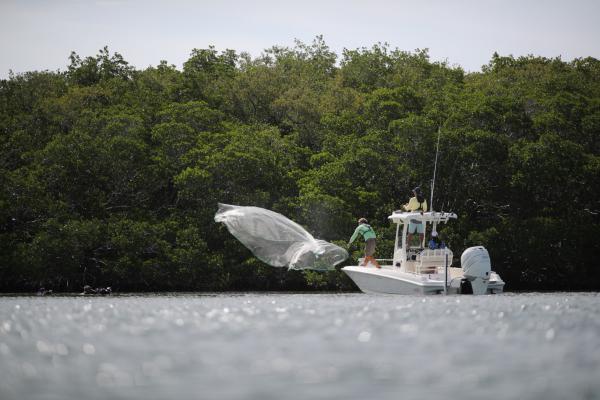
Bay boats are designed to function anywhere from foot-deep redfish and snook country to deeper, open-water sounds and harbors where game fish ranging from tarpon to striped bass hang out. These boats can also be run out the inlet in good weather to chase king mackerel, cobia, and Spanish among other nearshore species. They have less freeboard and deadrise than offshore boats, yet more of each than true flats boats designed to chase bonefish in ankle-deep water.
And they have livewells, often enormous examples of them, because many types of target bay species are far more vulnerable to live bait than to artificial lures.
Keeping More than Just Bait Alive
Some bay boats are also designed with an eye to redfish tournaments, where the fish must be brought to the scales alive to earn points. And since reds can be close to 30” (.76 m) long, it takes a big well to hold them. It’s best for all fish involved if the catch ends up in a different well than the bait.
Aftermarket Livewells
Some top fishing guides go for the nuclear option in baitwells, setting giant Jacuzzi-like aftermarket wells holding 50 gallons (189 L) and more on their aft deck. Using these wells, guides corral seemingly endless hordes of live sardines, threadfins or other baits, which they use not only as bait but also for live chum. These guys may literally castnet 500 baits or more before they even think of wetting a line, and it takes a very serious livewell to keep that many baits healthy.
The downside: These wells cramp the available fishing space in most bay boats. If you like to fish, but are not as dedicated a live baiter, it's much better to opt for a boat that has a big built-in well or two – keep reading.
Livewells for Family Fishing Boats
On the other end of the scale, some bay boats designated as "multi-mission" boats, partly for fishing, partly for water-skiing, swimming and day boating, may have wells holding as little as 15 gallons (57 L). While this is not much, it's enough to keep a couple dozen shrimp lively for a morning of chasing seatrout or mangrove snapper, or to keep a dozen eels alive for cobia or stripers, or a dozen pass crabs ready to volunteer for tarpon duty. It's too small to keep game fish alive, however.
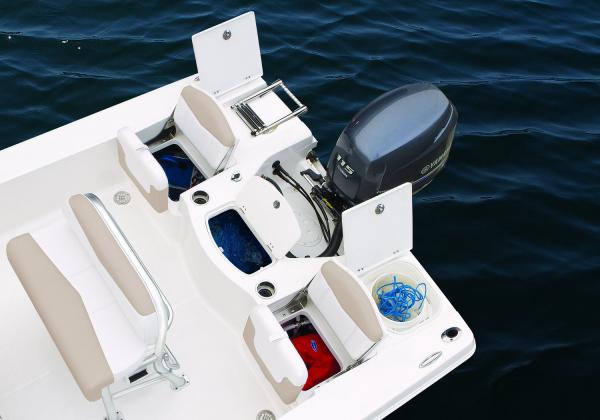
Live baits for inshore fishing are typically caught the morning of the fishing trip with a large castnet. Some baits, like pinfish and scaled sardines, can be lured into range with chum made of menhaden oil and commercial fish food or bread.
Other types of bait, like finger mullet, shad, menhaden and threadfins, must be "cowboyed." This means the angler runs the boat into range of a visible school and makes a quick throw of the castnet to trap them. Typically the angler will use a big, 10-foot net with plenty of weight on the lead-line, the cord that runs around the bottom of the mesh. The lead-line weights pull the net down quickly.
For lesser quantities of bait, anglers can use a rod outfitted with a Sabiki rig that has numerous small, fly-sized hooks. By dropping the rig around navigational markers, anglers can readily pull up enough blue runners and other baits on most days.
Baitwells for Serious Live-Baiters
For those who fish to live -- guides and pro anglers -- as well as those who live to fish, jumbo livewells are an essential feature in their bay boats. Some manufacturers take note of this and cater to it.
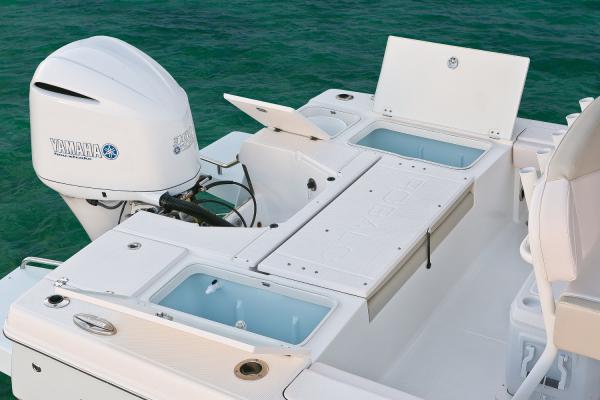
The Robalo 246 Cayman is particularly well set up for live baiting, with two big 30-gallon wells aft, so that one can be used to hold redfish, the other a whole bunch of bait. There's also a hatch sized to hold a 5-gallon (19 L) bucket adjacent. Castnets used to catch bait are routinely stored in these buckets to prevent tangles.
The 246 even has an additional "ready well" of 20 gallons (76 L) at the bow, so that anglers on both fore and aft decks have quick access to fresh bait.
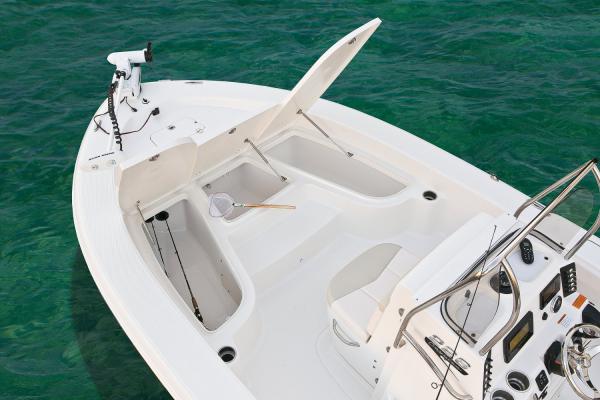
The Boston Whaler 240 Dauntless is also ready for all-day livebaiting, with a single 38-gallon (144 L) well in the aft deck, one of the largest in any bay boat.
The Mako 21 LT has a 30-gallon (114 L) aft well that includes a Pro-Air aeration system using dual air-stones to pump tiny bubbles into the well, adding aeration when it's closed. The Mako is supplied with a 1,000 gph pump, nearly twice the capacity found in some bass boats.
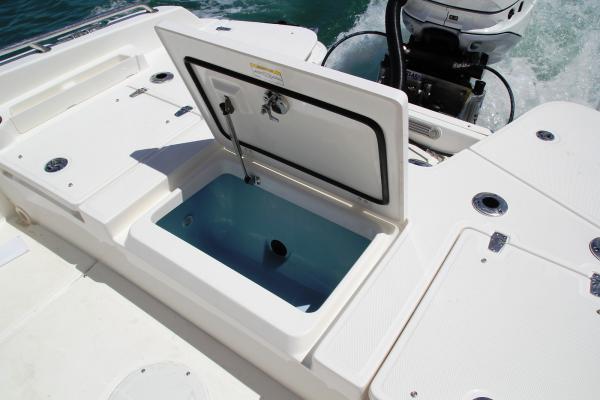
The Features of Good Livewells
These wells typically have insulating foam around them, to keep the temperature consistent. And the inside corners of the well are rounded so the bait does not stack up, stop swimming and die. They're often finished oceanic blue inside -- even though most inshore baits don't live that far offshore, the color is supposed to calm them.
Lights and Windows
Good anglers keep an eye on their baits. Waterproof LED lights make it easy to check on numbers and condition of the survivors. Wells built into the transom or the corner of the cockpit may have clear Plexiglas tops, also letting anglers see how the bait is doing.
A Supply of Clean Water
A well-designed livewell system will have a high-speed water pickup device on the transom, allowing the pumps to scoop water when the boat is on plane -- otherwise, the pump can sometimes lose prime and stop pumping, and the bait dies.
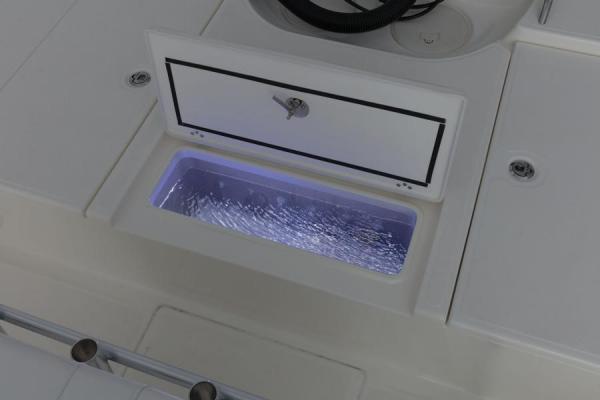
Aeration and Flushing
Because many saltwater baits generate a mix of ammonic urine, fish poop and shed scales, some method of maintaining a steady flushing of the wells is needed. That's why most bay boat livewells have "flow-through" aeration systems, rather than the closed systems common in bass boats. Aerated water is typically sprayed both on the surface and from other positions further down in the well, often in a pattern that will cause the water to rotate in the well and flow past the overflow pipe.
The outgoing water takes most of the crud with it, keeping the water in the tank relatively clean. Most livewells have a recirculating option so bait can be carried while the boat is on a trailer as well.
Keeping the Flow
The overflow typically has a removable screen on it to prevent the pipe from jamming with scales, undersize baits and other debris. The screen can be removed and rinsed any time it gets covered -- if not, it can make the well overflow into the boat.
There should also be a durable screen on the intake pipes for the baitwell pumps, because most bay boats frequently operate in areas where floating weeds are likely to be sucked in and jam the pumps otherwise.
Keeping Pumps Working
As on bass-boat livewells, pumps with easily removed cartridge-type motors are preferred -- if a motor burns out just as the angler finishes castnetting bait for an hour, it's not going to be a happy day on the water. Don't forget to carry a spare cartridge, and know how to install it before you need it.
Clean Up
As with bass-boat wells, livewells on bay boats need a thorough flushing after each day's use to keep your rig from smelling like a garbage scow. Some experts say a drop of biodegradable soap can help the process so long as you spray it out thoroughly afterwards. Never use any bleach-based cleaners -- the slightest hint of chlorine in the water can kill a whole tank full of bait almost immediately. Prop open hatch lids and let everything dry out overnight.
Handling Live Bait
There's a bit of an art to handling live bait -- it starts from the moment they're captured -- and a well-designed livewell can help. If a baitwell has a large hatch opening into it, the lower section of the castnet can be dropped into it and the net opened inside, releasing the bait directly into the water. This results in a much healthier bait supply than results from dumping the captive baits on deck and then scooping them up.
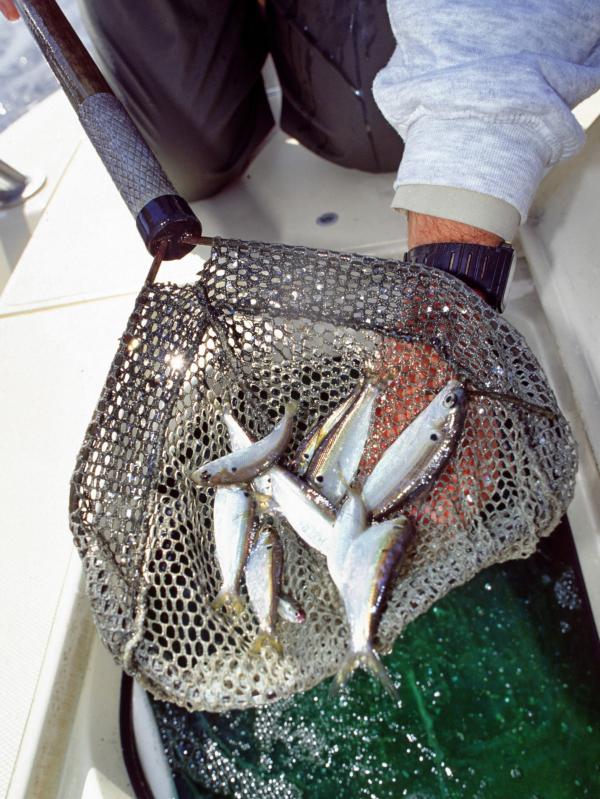
Using the Bait
Baits are best captured from the well with a small-mesh dipnet, with an 18" handle that allows one to reach the smart ones that flee to the corners of the tank. Floating models are easiest to keep track of and won't be lost if dropped overboard. The dipnet frame will typically measure 8" by 6" and is made of 3/8” nylon mesh.
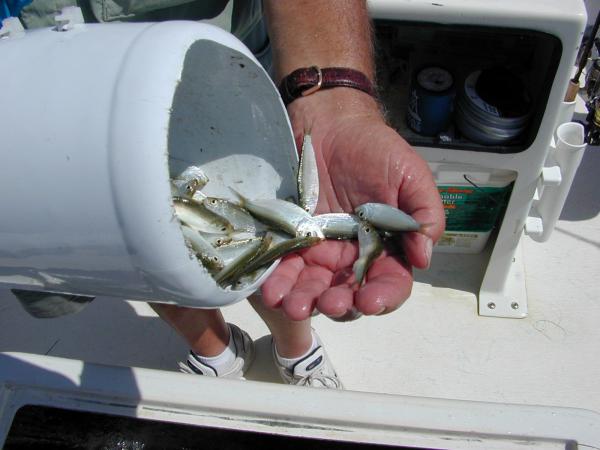
Live-Chumming Tactics
Many anglers have learned to turn on the bite of sometimes moody species like snook by using live baits as chum. They toss a dozen or so over the side and let the baits swim until they get into trouble -- the explosions at the surface reveal where the gamefish are hiding.
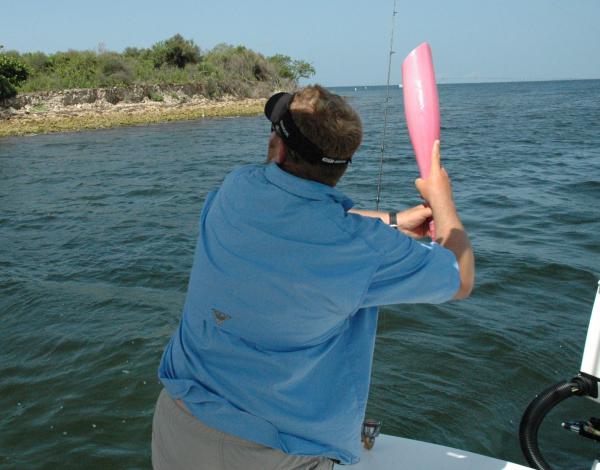
To get these baits to where they'll do the most good, some savvy skippers use a "bait bat," which is a children’s hollow plastic toy baseball bat cut off to have an angled, open end. Baits are dropped into the hollow bat and given a mighty two-handed swing that sends them well away from the boat into likely feeding areas.
Storing Bait Dockside
Some anglers keep baits used for tarpon, cobia and the like several days during the seasonal runs of these species. Rather than trying to maintain them in the baitwell, the best option is usually to get a net-pen that hangs from the dock, provided the dock happens to be in a harbor with decent tidal flush and aeration.
These pens enclose up to 100 gallons of water, giving the baits plenty of space to move around, and no electrical aeration system is needed so they don't draw down the boat battery. Baits like pogies, pinfish, grunts and pass crabs do well in these nets. More nervous and active baits like blue runners and ladyfish, on the other hand, do not -- they pretty much have to be caught and used in short order. Note that the grunts and pinfish are not overly stressed by this sort of captivity -- toss a handful of cut shrimp to them once a day and they will gobble it up and stay in prime shape, ready whenever you are, so long as oxygen is plentiful around your dock.